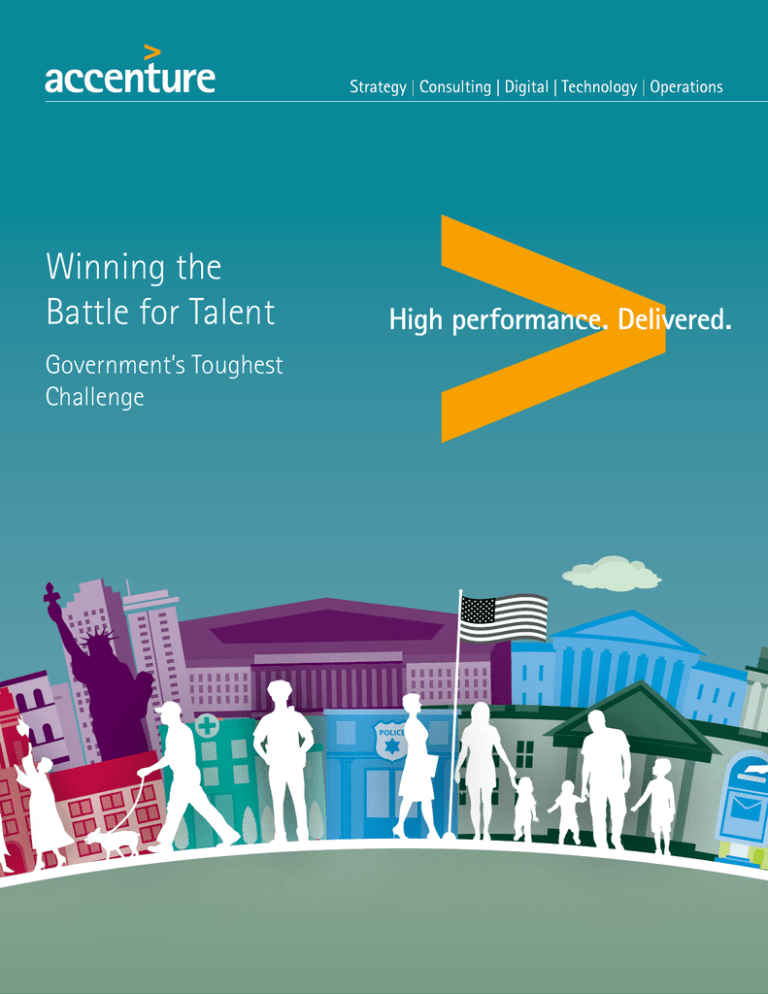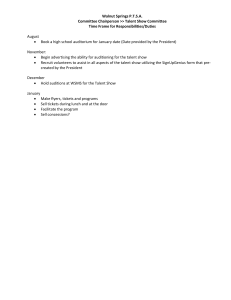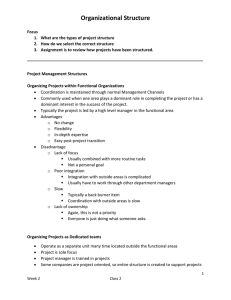
Winning the
Battle for Talent
Government’s Toughest
Challenge
Y
1
State and local governments are in a battle for talent
that will determine the quality of public services
for the foreseeable future. Yet, many state and local
leaders are going into that battle with outdated
strategies and tools. Yesterday’s promises of lifelong
employment and secure pensions—the traditional lures
of a career in public service—are not enough to attract
and retain tomorrow’s workforce. As demographic
forces reshape the market for talent, state and local
governments need to fundamentally change how
they define, discover, develop and deploy the talent
they need to deliver outcomes for the people and
communities they serve.
Talent crisis
The talent crisis governments face is the result
of rapid demographic changes. After decades of
continuous growth—indeed, for the first time
in its history—the US is facing a decline in the
percentage of the population that is of working
age. Baby Boomers are retiring and will do so
in ever-increasing numbers. At the other end
of the age spectrum, Millennials have come of
age and will add little additional growth to the
working-age population. As a result, employers
will have to compete for talent as they never
have before.
Talent is not the only challenge governments
face. The needs and expectations of the people
they serve are also changing dramatically. Our
population is better educated than ever, and
we have access to previously unimaginable
technological capabilities. As a result, the bar
for public service quality, speed and accessibility
has risen significantly—and governments need
workforces that can meet those demands.
In the 20th century, state and local
governments had a winning formula for
attracting talent. Workers traded lower pay
for higher benefits (including a pension) and
enjoyed built-in protections from politics and
favoritism—factors that are less attractive to
today’s prospective workers.
This is especially true for Millennials, who—
given their sheer numbers—are critical to
any talent strategy. By the end of 2015,
Millennials will constitute the nation’s largest
living generation (see Figure 1).1 This welleducated, ambitious, footloose generation
expects a lifetime of careers (not one career
over a lifetime). Being able to attract and
retain them is the key to winning the battle
for talent.
Accenture Public Service Insights: Recruiting
and Retaining Talent in the Public Sector—a
study recently completed by Accenture—
highlights the challenge. In the survey, citizens
who have had experience working for the
government are twice as likely to find public
sector employment attractive compared to
those who lack such experience. What’s more,
Millennials are significantly less likely than the
rest of the population to have had experience
working for government. In fact, while those
under 30 represent 26 percent of the private
sector workforce, they are only 14 percent in
state and local government.2 And, while job
security along with health and retirement
benefits have traditionally been seen as major
attractions of public sector employment,
these factors are significantly less important
to Millennials. In addition, Millennials are less
responsive to compensation-related actions as
a factor in retention.
Figure 1. Projected Population by Generation (In Millions)
90
81
75
Millennial
Gen X
65
50
Boomer
30
29
10
Silent
2014
Note: Millennials refers to the
population ages 18-34 as of 2015.
2028
2036
2050
Source: Pew Research Center tabulations of U.S. Census
Bureau population projections released December 2014
3
• Effective leadership
• Recruiting and hiring process
• Flexible work arrangements (such as
telecommuting)
• Career advancement
• Challenging work
• Professional development
These factors will determine whether state
and local governments win or lose the battle
for taIent.
A winning strategy in the battle
for talent
To win the battle for talent, governments
need to fundamentally change how they
define, discover, develop and deploy the
talent they need (see Figure 2). Accenture
believes successful governments will:
•Define talent based on the value added
and mission criticality of their skills
and competencies.
•Discover and attract talent by developing
talent pipelines directly to the sources of
those critical skills and competencies.
•Develop talent by targeting the potential
of people to acquire and demonstrate
critical skills and competencies.
•Deploy skilled talent into an agile
workforce with successful onboarding,
career mobility opportunities and
effective leadership.
Talent represents the critical link between
a government’s service strategy and its
outcomes—turning strategy into work and
work into results.
70
66
Like the rest of the population, Millennials see
the biggest differences in the attractiveness
of public sector versus private sector
employment in these factors:
1. Define
Define talent based on the value
added and mission criticality of their
skills and competencies. Doing so
enables governments to segment
talent requirements and focus
talent strategies.
Ask the critical questions
Define talent needs by answering the
following key questions:
• How critical is each role and its related
skills and competencies to achieving the
organization’s mission?
• How much value does the role and its
related skills and competencies directly
contribute to the organization’s success?
Four primary employee segments emerge
from such an analysis (see Figure 3):
1. MUST HAVE—High mission criticality
and high value added. This segment
comprises those roles and related skills and
competencies that are vital to achieving the
government’s mission and add substantially
to its success. Governments need to focus on
ensuring that these “must have” roles are always
filled by high performers—whether as full-time
employees or through long-term contracts.
2. SPECIALIZED—High mission criticality
and mid to low value added. This segment
comprises those roles and related skills and
competencies that are critical to achieving
the government’s mission but that add less
value in contributing to its success. Examples
include mission-critical roles needed only
occasionally or those requiring a unique
specialty. Governments need to focus on
ensuring that these roles are filled and
available with high performers when needed.
To that end, they could share a resource with
others that have the occasional need for the
same specialized skills and competencies.
3. MAYBE IN, MAYBE OUT—Mid to low
mission criticality and high value added.
This segment comprises those roles and
related skills and competencies that are less
critical to achieving the government’s mission
but add substantial value in contributing to
its success. For this segment, governments
need to pursue a mixed strategy of direct
employment supplemented by outsourced
contractors to supply specific skills or to
execute defined tasks or projects.
systems that emphasize the content of the
work and supervisory relationships. This
new approach focuses instead on skills and
competencies needed to do the work.
• Maintaining discipline in assessing each
role’s value and mission criticality. There
will be a natural tendency for “assessment
inflation,” which needs to be resisted if
the result is to be strategically powerful.
Having and using predefined criteria can
help assure consistency and discipline.
4. SUBSTITUTE TECHNOLOGY—Lower
mission criticality and lower value added.
This segment comprises those roles and
related skills and competencies that are both
less critical to achieving the government’s
mission and add less value in contributing to
its success. These tend to be roles performing
routine tasks for which technology can be an
effective substitute.
Creating this segmentation requires:
• Redefining all roles in terms of the skills
and competencies they require. Such an
approach marks a major departure from
traditional job description/job classification
While every workforce segment is important
to the success of the overall organization,
each has distinct current and future talent
needs and strategies to fulfill them. Getting
these definitions right and the segmentation
complete is critical to any talent strategy.
Figure 2. Integrated Talent Management Framework
DISCOVER
Attract and
Source Talent
Agency
Mandates,
Missions,
Services
DEFINE
Talent
Needs
AGENCY
STRATEGY
DEVELOP
Talent
Potential
MEASUREMENT
AND
ALIGNMENT
DEPLOY Talent
Right Place,
Right Time
Figure 3. Segmenting the Government Workforce
HIGH
Critical to
Mission of
Organization
2
1
4
3
LOW
HIGH
Value Added to Organization
4
HIGH
BUSINESS
RESULTS
2. Discover
Discover and attract talent by
developing talent pipelines directly
to the sources of critical skills and
competencies. These pipelines enable
governments to attract and secure
the right talent at the right time.
Use HR analytics to take you to
the source
The first step to building a talent pipeline:
identify the sources of the best talent.
Although governments have the data
they need to pinpoint their best sources
of successful talent, most cannot turn it
into useful information. HR analytics can—
providing answers to these questions:
• Of our hires in the past five years, which
have been the most successful?
• Where have our most successful hires
come from? How did we connect with and
recruit them? How long did it take? How
about our least successful hires?
• Of those successful hires, what have been
their career paths within our government?
In what ways were they best prepared?
Worst prepared?
Answering these questions can unlock critical
information about sources of talent that
are already working. With that knowledge,
governments can point to other, similar
sources of talent. Having multiple sources is
the best way to assure reliable supply.
Build pipelines to the best
sources
A talent pipeline between a government and
a provider or source of supply (for example,
an educational institution, nonprofit or
placement organization) is created through a
set of mutual commitments.
The government commits to:
• Specify the skills and competencies it is
looking for, along with the level of quality
it expects.
• Provide feedback on the skills and
competencies being produced.
• Provide learning opportunities, such as
internships, apprenticeships, shadowing
and direct instruction.
The provider commits to:
• Prepare candidates who meet the
specifications.
• Modify recruitment and preparation based
on employer feedback.
• Provide feedback on government-provided
learning opportunities.
In a time of intense competition for talent,
pipelines can reduce the risk of not having the
right talent, not having enough talent and not
having it at the right time.
Enlarge the pool of
available talent
In a fast-changing world, being a slowchanging organization can actually
limit access to talent. Rules, policies and
procedures that were assets in the past may
be liabilities today. Changing them could
open up new pools of talent.
Consider enlarging the pool of available
talent through:
• Flexible work arrangements. Make time,
place and duration flexible.
—Use telecommuting and remote
work sites to open up your talent pool
to those with time and geographic
limitations. (Doing so also will reduce
the cost of building and maintaining
offices.)
5
Although governments
have the data they
need to pinpoint
their best sources of
successful talent, most
cannot turn it into
useful information.
—Create fellowships to allow subjectmatter experts with high-demand skills
to share expertise and best practices
with government agencies for a predetermined time. A good example at
the federal level is the Presidential
Innovation Fellows program, which pairs
government employers with private
sector workers, including software
developers and technology professionals,
in six- to 12-month partnerships.3
Other governments could launch
similar initiatives—recruiting industry
professionals interested in public service
and providing targeted benefit packages
for one- to two-year programs.
—Use part-time work to attract
people with competing commitments
(such as education or caregiving),
and individuals who do not want
a set “nine-to-five” schedule. Such
candidates help employers fill positions
with variable demand.
• Flexible compensation structures. To
start competing on stronger footing with
the private sector, governments should
create flexible compensation and benefits
models that allow tailoring of components
to fit the skills and competencies required
in different talent segments and in
pursuing different talent strategies.
• Education assistance. The education debt
of Americans under 30 has increased from
$13,000 to $21,000 since 20054 and may
be a factor pushing Millennials to seek
private sector work. To counter this trend,
governments could round out benefit
and compensation packages with tuition
assistance, student loan forgiveness,
education credit offsets or other
similar programs.
• Re-engagement of experienced
workers. For experienced professionals
who want to delay retirement, give back
to their community, pursue a change of
pace or learn something new, government
employment in some form could be very
attractive. By targeting certain roles with
short durations, part-time hours or flexible
work conditions, governments could open
up new pools of experienced talent.
• Go digital; move fast. For Millennials in
particular, the entire recruiting and hiring
process must be digital, using both the web
and social media, and it must move quickly.
If processes are in line—not online—these
candidates won’t be in the pool.
• Reinvent job classifications. Today’s
classification systems are too complex,
too focused on titles and supervisory
responsibilities, and too often full of jargon
and acronyms that confuse and alienate.
A reinvented classification system would
emphasize skills and competencies. It would
make it easier for prospective employees
to select the proper education and training
programs to prepare themselves, and for
experienced employees to evaluate how
their specific skills and competencies
compare to role requirements. It also would
offer more agile careers, allowing mobility
among state agencies and between state
and local levels of government. Many
transferable skills are in demand across
all governments, and they should take
advantage of the ability to share a common
resource. By using a shared workforce
model, a government can invest in training
and benefits for an employee knowing they
will be able to apply their skillset in more
than one agency or department.
In the battle for talent, the best ways for
government to assure it gets the talent it
needs is to identify its best sources, build talent
pipelines to those sources, and then expand the
pool of talent from which it can recruit.
6
Highlight:
Increasing job
retention (more than
just a pay raise)
According to Accenture’s recent talent
survey, compensation isn’t the only
factor in increasing retention.
These are also powerful:
• Productive relationship with
my manager
• Opportunities for advancement
• Skill development opportunities
• Flexible work arrangements
• Recognition from leadership
3. Develop
Develop talent by targeting the
potential of people to acquire and
demonstrate critical skills and
competencies.
Today’s workers are tomorrow’s
public service workforce
The vast majority of the workforce we will
have in 2030 is already at work today. Thus,
today’s workers are every government’s
largest future talent pool. But will they have
the skills and competencies governments
need to meet the ever-rising expectations
of those they serve? The answer is far
from certain.
The Accenture 2014 College Graduate
Employment Survey found that, while more
than three-quarters of college graduates
expect their employer to provide formal
training programs for skills necessary to
advance their careers, less than half receive it
(see Figure 4).5
Accenture’s recent survey reinforced that
finding, highlighting the importance of
professional development and career
advancement as critical factors in making
public sector employment attractive and in
retaining talent.
No government can win the battle for talent
if it loses the fight to equip today’s workers
with the skills and competencies they need to
succeed. Doing so requires:
• Making skills and competencies the
“currency” for talent development.
That includes specifying the skills and
competencies required for each role and
using skill and capability matching to
identify career opportunities.
• Having the ability to assess and certify
skills and competencies through
demonstration. Skills and competencies
exist only in practice. A “show what you
can do” approach is key to assuring that
skills and competencies exist at the level
required for success.
• Creating an internal profile or transcript
for each employee to track his or her
accumulation of skills and competencies.
This profile will be critical for helping
employees chart their paths to new
opportunities and for helping employers
visualize the talent pools they have and
those that need to be developed.
Figure 4. Employer Training Expected/Provided
80%
80% of 2014 college grads expect
their employer to provide a formal
training program in their first job
48%
48% of 2012/2013 grads received
formal training in their first job
Source: Accenture’s Great Expectations report
7
• Using multiple methods to develop skills
and competencies. These include:
— On-site classroom learning
— Experiential, project-based learning
— Apprenticeships, coaching and feedback
— Computer-based training and simulations
— On-the-job, real-time decision and
task support (for example, job aids,
searchable knowledge and insights,
step-by-step process guides, afteraction reviews)
— Small group, peer-based learning
— Gamification and badging to make
the learning experience more
interesting, memorable and relevant
to today’s workers
— External programs that grant degrees
or certifications
4. Deploy
roles, capitalizing on transferable skills and
explaining how they can be leveraged in
different segments of the organization. The
crucial message (especially to Millennials):
“You can have as many careers as you
want—right here.”
Onboarding on purpose
By enhancing workforce mobility,
governments can increase retention of critical
skills while increasing government’s ability
to respond to the ever-rising and changing
expectations of those they serve.
Deploy skilled talent into an agile
workforce with successful onboarding,
career mobility opportunities and
effective leadership.
An employee’s first days in a new job often
involve a whirlwind of new and exciting
experiences. But that excitement can quickly
give way to anxiety—unless employers use
onboarding as a chance to integrate new
hires into the organization and prepare
them for success.
Onboarding should be purposeful about
assuring that every new employee:
• Knows his or her role and the connection
between that role and the purpose of
the organization.
• Clearly understands performance
expectations, performance information
and the assessment process.
• Connects with colleagues.
• Begins making a contribution as soon
as possible.
• Has a coach and gets performance
feedback early and regularly.
Every new employee is a gift to an
organization. Effective onboarding makes
the most of that gift—for employees and
the organization.
Encouraging mobility
To develop workforce agility, public
service organizations need to encourage
mobility—both vertical (promotions) and
horizontal (transfers). The ability to switch
between roles that require similar skillsets
helps diversify an employee’s career,
retains talent within a government and
improves workforce agility. For example,
the Washington State Career Opportunities
website notes, “As your knowledge and
skills grow, so will your options. You’ll likely
find opportunities for advancement within
your agency, or you can check out similar
jobs in other organizations.”6 Government
career models should stress the ability to
experience multiple career paths and job
Leading beyond performance
management
In the past, the HR department was
responsible for providing talent. In that
design, leadership focused almost exclusively
on holding talent accountable for its
performance of established processes. That
approach was possible when talent was
plentiful and could be readily replaced and
when work focused more on processes than
on outcomes, change or innovation.
Today, however, talent is scarce. It is hard
to replace. And, governments must find
and keep the talent they need to meet the
relentlessly changing expectations of the
people they serve. In this environment, the
expectations of leadership must change as
well. To succeed, every leader must become
a talent manager responsible for defining
what they need, finding it, developing it and
deploying it successfully over time.
Of course, most of today’s leaders were
“trained” by our 20th-century talent system
to complain and blame HR without assuming
responsibility and accountability for their
teams’ talent. That must change. We must
prepare our leaders for the battle ahead—
arming them with the skills, competencies
and tools to win.
New leaders will need to be able to:
• Segment their talent needs based on
value added and mission criticality,
creating and executing talent strategies
unique to each segment.
8
• Connect skills and competencies to roles,
and roles to results.
• Identify talent pools, and then build and
sustain pipelines to those sources of
talent.
• Target, track and manage the development
of needed skills and competencies within
the workforce.
• Assure that onboarding prepares new
employees to succeed.
• Encourage and manage mobility to retain
critical skills and make the workforce
increasingly agile.
Gaining a competitive edge
Governments are in a perpetual battle for
public support. To win it, they must first
win the battle for talent. Accenture’s recent
talent survey suggests they can. One-third
of the overall population—and one-half of
those with experience in government—are
attracted to work in the public sector. But
Accenture’s recent study shows that leaders
in government are not doing enough:
• Two-thirds of government leaders are
already finding it hard to recruit and
retain talent.
• Only one in 10 feel prepared to meet the
challenge of attracting and retaining the
talent they need.
• Almost half have made little to no change
in their approach to talent management
in the last two years.
Governments have tried several approaches
that have proven effective in making public
sector employment more attractive. These
include better opportunities to make a
meaningful difference to society, more
inspiring leadership and greater clarity about
how each role contributes to the mission.
Even so, they have not pursued other
approaches identified by potential employees
to the same degree or with the same
effectiveness—including better/more flexible
career advancement opportunities, better
professional development opportunities
and better compensation.
Conclusion
To win the battle for talent, state and local
governments need to fundamentally change
how they define, discover, develop and
deploy the talent they need. Failing to act is
admitting defeat—dimming the prospects for
our public services and, ultimately, for the
people and communities they serve. The time
to start is now.
Methodology
In March 2015, Accenture conducted an
online survey of US voting-age citizens.
The purpose of the study: to gauge citizen
attitudes toward public sector careers and
employment, identify factors that make
public sector employment attractive, and
determine how to improve recruitment and
retention of public sector employees. Study
results are based on a census-representative
sample of 1,103 US voting-age citizens.
Results for citizens are statistically significant
with a confidence level of 95 percent and a
margin of error of plus or minus 3 percent.
As part of the same study, Accenture
surveyed public service leaders to identify
talent management approaches they use,
compare their perspective to citizen attitudes
and preferences, and determine how to
improve recruitment and retention of public
sector employees. Results are based on an
online survey completed by 72 leaders from
18 states and the city of New York in March
and April 2015.
9
For more information,
please contact:
Breck T. Marshall
Managing Director,
Talent & Organization Practice
Health & Public Service
breck.t.marshall@accenture.com
Peter C. Hutchinson
Managing Director, Public Service Strategy
Health & Public Service
peter.c.hutchinson@accenture.com
William Kilmartin
Director, Public Service Strategy
Health & Public Service
william.kilmartin@accenture.com
Connect with us to learn more on
delivering public service for the future
on Twitter @AccenturePubSvc.
References
1. “This year, Millennials will overtake Baby
Boomers” Pew Research Center, Washington,
DC (January, 2015) http://www.pewresearch.
org/fact-tank/2015/01/16/this-yearmillennials-will-overtake-baby-boomers/
2. http://www.icmarc.org/documents/
educomm/briefing201210.pdf
3. http://blogs.wsj.com/atwork/2014/06/11/
calling-all-millennials-the-governmentwants-you/
4. http://www.bls.gov/opub/mlr/2014/beyondbls/millennials-after-the-great-recession.
htm
5. http://www.accenture.com/
SiteCollectionDocuments/PDF/Accenture2014-College-Graduates-Survey.pdf
6. http://careers.wa.gov/benefits.html
UNIVERSITY
11
About Delivering Public Service
for the Future
What does it take to deliver public service
for the future? Public service leaders must
embrace four structural shifts—advancing
toward personalized services, insight-driven
operations, a public entrepreneurship mindset
and a cross-agency commitment to mission
productivity. By making these shifts, leaders
can support flourishing societies, safe, secure
nations and economic vitality for citizens in
a digital world—delivering public service for
the future.
Copyright © 2015 Accenture
All rights reserved.
Accenture, its logo, and
High Performance Delivered
are trademarks of Accenture.
About Accenture
Accenture is a global management
consulting, technology services and
outsourcing company, with more than
336 ,000 people serving clients in more
than 120 countries. Combining unparalleled
experience, comprehensive capabilities
across all industries and business functions,
and extensive research on the world’s
most successful companies, Accenture
collaborates with clients to help them
become high-performance businesses and
governments. Through its Skills to Succeed
corporate citizenship initiative, Accenture
is equipping more than 3 million people
around the world with the skills to get a job
or build a business. The company generated
net revenues of US$30.0 billion for the fiscal
year ended Aug. 31, 2014. Its home page is
www.accenture.com.






